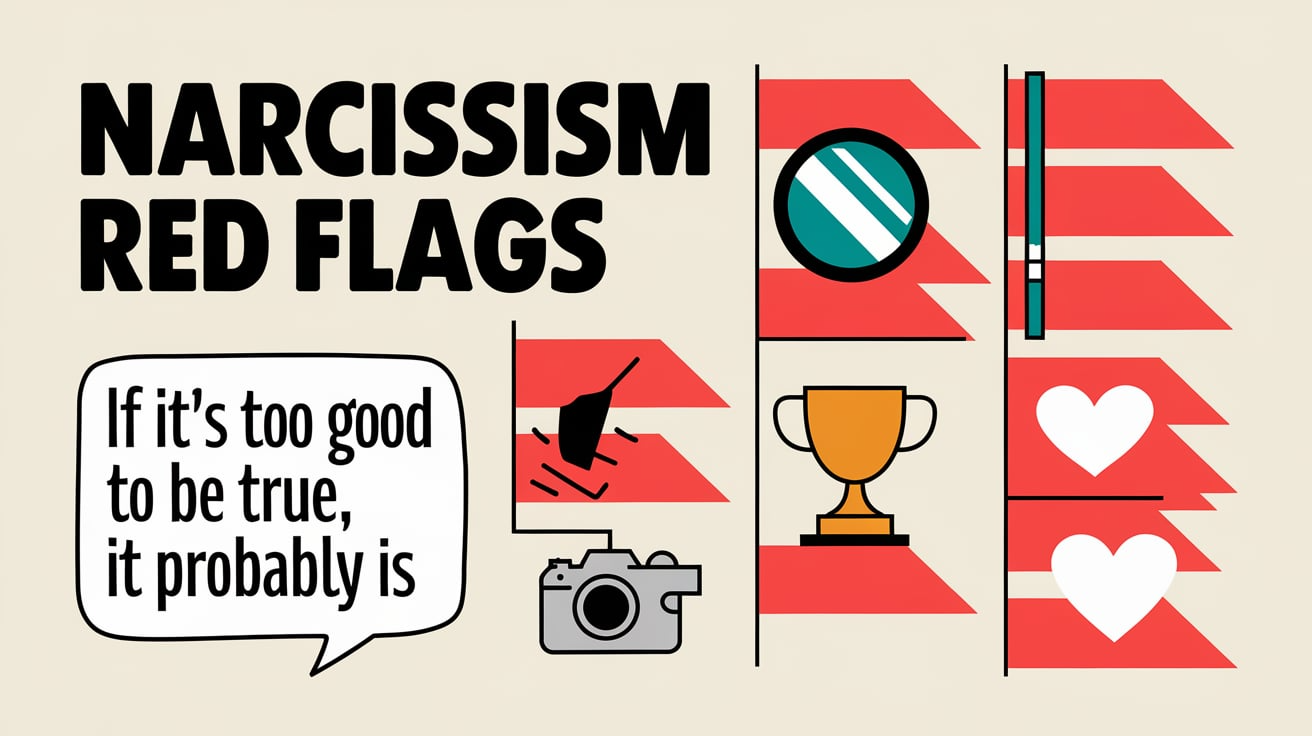Are you continually questioning your reality in a relationship?
Understanding narcissistic behavior patterns early can save you from years of emotional turmoil.
While no single trait definitively indicates narcissism, certain red flags often cluster together, painting a clearer picture of narcissistic personality traits.
This comprehensive checklist isn’t just about spotting warning signs – it’s about trusting your instincts and protecting your mental well-being.
If you’re in a romantic relationship, dealing with a family member, or navigating a workplace dynamic, these indicators can help you identify narcissistic behaviors before they impact your life significantly.
What is Narcissism
Narcissism is a complex behavior pattern where individuals seek constant admiration and validation while lacking empathy for others.
Unlike healthy self-confidence, narcissists often manipulate relationships to fulfill their need for praise and approval.
This can lead to unhealthy dynamics, where others are used to boost the narcissist’s self-esteem.
Recognizing these behaviors is key to protecting your emotional well-being, setting boundaries, and maintaining healthier, more balanced relationships.
What is a Narcissistic Red Flag Checklist

A narcissistic red flag checklist isn’t merely a tool for judgment but a crucial shield for your emotional well-being.
The most telling signs include love bombing – an overwhelming display of affection early in relationships that feels too intense too soon.
Pay attention to their reaction to boundaries – narcissists often respond with rage or emotional manipulation when limits are set.
Notice how they handle criticism, even mild feedback – a narcissist typically deflects, becomes defensive, or turns the situation around to blame others.
Look for signs of empathy deficit in everyday situations, like dismissing your feelings or showing irritation when you’re sick or need support.
The presence of gaslighting – making you question your reality – combined with a constant need for admiration and control over your relationships with others forms a clear pattern of narcissistic behavior that shouldn’t be ignored.
Key Points of Narcissistic Red Flag Checklist

Now that you understand what a red flag checklist is, here are some key points to check for red flags in a narcissist:
1. Excessive Need for Attention and Validation
Narcissists often crave constant admiration and praise, which drives their behavior in social interactions. They tend to dominate conversations, frequently interrupting others and steering the focus back to themselves.
This relentless need for attention is a key indicator of narcissistic tendencies, as they seek validation and recognition at the expense of others.
2. Lack of Empathy
A hallmark of narcissism is the inability or unwillingness to understand or care about others’ emotions.
Narcissists may dismiss others’ feelings, fail to offer support, or only show interest when it benefits them.
Over time, this pattern becomes clear, revealing that they prioritize their own emotions above those of others.
3. Exaggeration of Achievements or Talents
Narcissists often exaggerate their accomplishments and abilities to present themselves as superior.
They frequently highlight their successes or claim expertise in areas where they have little real experience.
This arrogance is typically accompanied by an expectation that others will admire them without question.
4. Preoccupation with Power, Status, or Appearance
Many narcissists obsess over social status, physical attractiveness, and professional prestige, often placing high importance on superficial qualities.
They may frequently name-drop, showcase expensive possessions, or emphasize outward appearances to maintain their image.
This intense focus on external markers of success can overshadow more meaningful personal connections as they prioritize status over genuine relationships.
5. Entitlement and Expectation of Special Treatment
Narcissists often believe they deserve more respect, privileges, or opportunities than others. When they don’t receive special treatment, they may become angry or indignant.
This sense of entitlement can show itself through both subtle behaviors and overt demands, reflecting their expectation of being treated differently from those around them.
6. Manipulative or Exploitative Behavior
A narcissist may use others to achieve their goals, often without considering the consequences.
They might charm people into doing things for them, gaslight others to make them doubt their perceptions, or play one person against another.
This manipulation leaves others feeling used and uncertain of their own judgment as they struggle to handle the narcissist’s tactics.
7. Inability to Handle Criticism
Even mild feedback can provoke an extreme reaction from narcissists. They often respond to criticism with anger, denial, or attempts to shift the blame onto others.
Over time, this inability to accept responsibility becomes a clear red flag, revealing their difficulty in handling any form of negative feedback.
8. Tendency to Dismiss Boundaries
Narcissists often react intensely to even mild feedback, responding with anger, denial, or attempts to shift blame onto others.
This inability to accept responsibility over time becomes a clear red flag, highlighting their struggle to handle any form of negative feedback.
Importance of Identifying a Narcissist
| Key Concept | Explanation |
|---|---|
| Protecting Mental Health | Narcissistic abuse can lead to anxiety, depression, and self-doubt. |
| Maintaining Healthy Boundaries | Recognizing narcissistic behavior helps in setting firm boundaries. |
| Breaking Destructive Cycles | Awareness helps break trauma bonding, where emotional attachment to the abuser persists. |
| Preserving Other Relationships | Narcissists isolate their targets from friends and family. |
| Professional Impact Protection | Recognizing narcissistic traits helps protect career, work relationships, and reputation. |
Ways to Cope with a Narcissistic Person
- Set Clear, Non-Negotiable Boundaries: Establish firm limits on what you’ll accept and maintain them consistently, regardless of guilt trips or manipulation attempts. Your boundaries are not up for debate.
- Practice the Gray Rock Method: Keep interactions minimal and emotionally neutral. Don’t share personal information or show strong reactions that could fuel their need for drama or control.
- Document Everything: Keep records of conversations, agreements, and incidents. Save emails, texts, and important communications. This protects you from gaslighting and manipulation.
- Build Your Support Network: Maintain strong connections with friends and family. Don’t isolate yourself, even if the narcissist pressures you to do so. Your support system is crucial.
- Focus on Emotional Independence: Develop self-validation skills. Don’t seek their approval or take their criticism personally. Your worth isn’t determined by their opinion.
- Learn to Identify Manipulation: Study their patterns and tactics. Being able to recognize love bombing, gaslighting, and other manipulation techniques helps you respond appropriately.
- Prioritize Self-Care: Maintain your mental health through therapy, meditation, exercise, or whatever works for you. Your well-being comes first.
- Plan Your Exit Strategy: If the relationship becomes toxic, have a practical plan ready. Know your resources, support options, and legal rights if needed.
- Control the Controllable: Focus your energy on what you can change rather than trying to change it. Accept that their behavior likely won’t improve.
Conclusion
Identifying narcissistic red flags isn’t about condemning others – it’s about protecting your emotional well-being and fostering healthier relationships.
While these warning signs can help you handle potentially toxic situations, remember that everyone occasionally displays some narcissistic traits.
The key is recognizing persistent patterns that impact your mental health and boundaries.
Go with your gut. If something feels wrong in a relationship, it probably is. You don’t need to have all the answers or clear evidence of narcissistic behavior to prioritize your well-being.
Remember, healing from narcissistic abuse takes time, but recognizing these red flags is your first step toward emotional freedom and healthier relationships.








